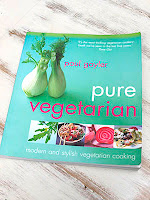From Terre à Terre:
The Vegetarian Cookbook, Amanda Powley with Philip Taylor, Absolute Press,
2009.
I always get a kick out of making something from this book.
The recipes are fun to make and the resulting dish is just as much fun to eat
as it is packed with flavour.
The turtle beans had been soaking so they were drained, put
in a pot with cold water, brought to the boil and kept on the boil for about 10
minutes. They were now drained again.
The chillies were drained with the water kept, deseeded and chopped finely.
I gathered together a teaspoon of cumin seeds and about the same amount of
coriander seeds, a bay leaf and a large pinch of dried thyme. All of these
elements went in a saucepan with olive oil for about a minute until the herbs
released their aromas. Into this mix went a chopped carrot, a finely chopped
celery stalk and half a red capsicum, chopped. The lid was placed on and the
vegetables left for about 10 minutes to release their juices. Now in went the
beans, about a litre of water and the water from the soaked chillies. This was
all brought to the boil and simmered until the beans were soft, about an hour and
a half. When the beans were soft the soup was puréed in a blender,
strained and left until ready to be served.
The salsa was simple a matter of chopping up the ingredients
finely, mixing them together and putting them in a covered basin in the fridge
until time to serve. While the recipe called for four garlic cloves I only used
half of one. That seemed to be adequate when I tasted the salsa.
The plantain fritters were made by peeling a plantain,
cutting it into 3cm lengths and then frying them until they were soft enough
for a knife point to go into them easily. They were then pressed between two
sheets of baking paper to make the fritter shapes. Just before serving they were deep fried until crisp and sprinkled with a dust made from grinding in a
mortar roasted cumin seeds, salt, smoked paprika and black pepper seeds.
As usual with Terre à Terre
recipes this was an absolute pleasure to eat. The soup was richly savoury and
chilli hot, the salsa a mix of fresh vegetables enhanced by lime and cumin
seeds, and the plantain fritters perfect scoops for the salsa. Interestingly we
had some salsa left and finished it off by using commercial corn chips. The
difference between fresh flavours and commercial, probably chemical ones, was
marked.
Taste: ✔✔✔✔
Ease of
cooking: ✔✔✔






























